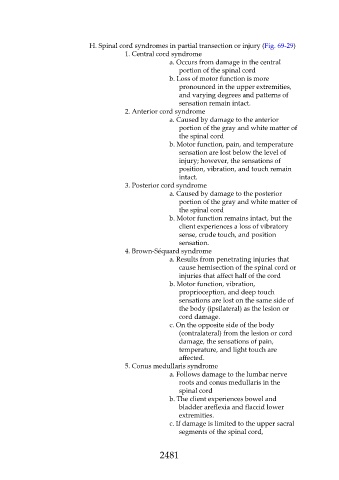Page 2481 - Saunders Comprehensive Review For NCLEX-RN
P. 2481
H. Spinal cord syndromes in partial transection or injury (Fig. 69-29)
1. Central cord syndrome
a. Occurs from damage in the central
portion of the spinal cord
b. Loss of motor function is more
pronounced in the upper extremities,
and varying degrees and patterns of
sensation remain intact.
2. Anterior cord syndrome
a. Caused by damage to the anterior
portion of the gray and white matter of
the spinal cord
b. Motor function, pain, and temperature
sensation are lost below the level of
injury; however, the sensations of
position, vibration, and touch remain
intact.
3. Posterior cord syndrome
a. Caused by damage to the posterior
portion of the gray and white matter of
the spinal cord
b. Motor function remains intact, but the
client experiences a loss of vibratory
sense, crude touch, and position
sensation.
4. Brown-Séquard syndrome
a. Results from penetrating injuries that
cause hemisection of the spinal cord or
injuries that affect half of the cord
b. Motor function, vibration,
proprioception, and deep touch
sensations are lost on the same side of
the body (ipsilateral) as the lesion or
cord damage.
c. On the opposite side of the body
(contralateral) from the lesion or cord
damage, the sensations of pain,
temperature, and light touch are
affected.
5. Conus medullaris syndrome
a. Follows damage to the lumbar nerve
roots and conus medullaris in the
spinal cord
b. The client experiences bowel and
bladder areflexia and flaccid lower
extremities.
c. If damage is limited to the upper sacral
segments of the spinal cord,
2481

